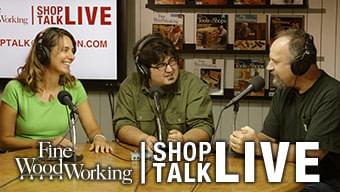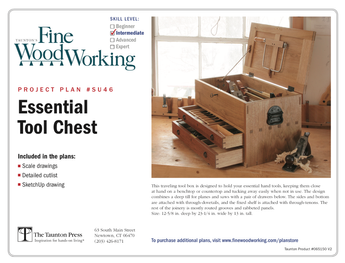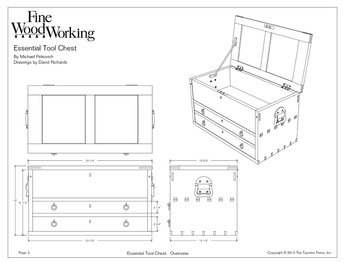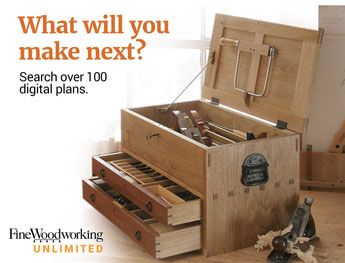So I’m a hobbyist woodworker with only so much knowledge/exp.
Discussion Forum
Get It All!
UNLIMITED Membership is like taking a master class in woodworking for less than $10 a month.
Start Your Free TrialCategories
Discussion Forum
Digital Plans Library
Member exclusive! – Plans for everyone – from beginners to experts – right at your fingertips.
Highlights
-
Shape Your Skills
when you sign up for our emails
This site is protected by reCAPTCHA and the Google Privacy Policy and Terms of Service apply. -
 Shop Talk Live Podcast
Shop Talk Live Podcast -
 Our favorite articles and videos
Our favorite articles and videos -
E-Learning Courses from Fine Woodworking
-
-
 Fine Woodworking New England Event
Fine Woodworking New England Event -












Replies
I’ll be watching this. I’m planning to build a ¼ sawn white oak coffee table in the A&C style. I’ve always read to secure the top with a fixed screw in the centre (across grain) at opposite aprons (2 screws total) and ‘float’ all other attachments using clips riding in a routed channel. Essentially keeping the top from lifting bust allowing movement side to side.
I have actually build small pieces and fixed with a single screw in the centre of the apron, one on each long side, and never added any additional fasteners. My thinking is the weight of the top and the single fastener will prevent it from accidental movement (bad children) while allowing maximum wood movement.
If I don't get any responses I figure I might just screw the apron/skirt to the table top at the end of the apron(middle of the table) on each side(The table splits in the middle to extend).
And use z-clips or something similar in a groove in the apron the rest of the table. This would allow the top to expand ONLY "outward" towards the two ends of the table.
I also really don't think they're be very much expansion with it being quarter sawn, I'm just worried seeing it's not for myself.
I also don't understand why the wooden extension slides that are screwed across the width of the grain wouldn't cause the same problem?
So I got the Rockler slides in. There's no elongation in the screw holes. Nor does it seem there's much space in the holes for movement with what I would imagine would be the recommended screw size.
It just seems weird to me one of the most popular online woodworking source companies didn't account for wood movement.
Also, I took a picture of a table(pic attached) I have that's an antique and although the aprons are not Mortised into the legs or attached other than the corner braces, it does have screws(ostensibly pocket hole) from the apron directly into the top with no apparent allowance for movement. The width of the tabletop(one side) is 13.5 in. Not a tremendous amount of wood but I would assume it could move up to 3/32-1/8.
But no problems with this top warping or cracking and I'm guessing it's 50+ yrs old.
I'll try and cover what I can.
1. Osbourne is a reputable company
2. Quartersawn will lessen the movement
3. Pocket holes attaching an apron is fine, there can be enough room for expansion if done properly
Any movement will be minimal. I would say 3/32" max. This is then divided by two (1 screw on each side). The result is thare really isn't too much to worry about.
A pocket hole is essentially a butt joint, if you're concerned, simply oval out the screw holes to allow for some movement.
Thank you.
Is your estimation of 3/32 because I'm using quartersawn or is that for plainsawn?
Also, I've heard a general rule to be 1/8 per foot(alot of variables though). Do you agree with that?
I have a 54" round walnut dining table, with 2 halves that open up for leaves. It was factory made, and the apron halves were attached with pocket screws. They split one of the table halves into two pieces, as they did not allow adequate room for the movement of the top (and walnut is considered stable; it has relatively low expansion and contraction, and its ratio between radial and tangential is almost 1). Don't attach your top with pocket screws. Use buttons or clips except for the center screws that keep it fixed in place. Don't use just the center screws; the other fasteners are there to keep the top flat. Oak is prone to cupping, tho quartersawn is much less so. The weight of the top is not sufficient to keep it flat.
Make the holes for the leaf extension mechanism somewhat oversize to allow for movement. Sometimes it is helpful to use a washer. I often glue a batten to the inside of the apron, with a normal hole in the middle, and elongated holes out from there.
Thanks for your input.
The factory I worked for built 50 tables per day for over 50 years using this same technique and I ‘ve never seen a split top . The wood was kiln dry maple dried on site and the rails, some straight some half circles were attached with pocket screws. In addition, the extension rails also were cross grain as well as the stiffeners on longer tables, I remember those were screwed in oversize holes.